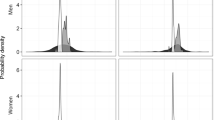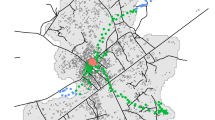Abstract
Background
Experimental studies suggest ultrafine particles (UFPs), the smallest size fraction of particulate matter, may be more toxic than larger particles, however personal sampling studies in children are lacking.
Objective
The objective of this analysis was to examine individual, housing, and neighborhood characteristics associated with personal UFP concentrations as well as the differences in exposures that occur within varying microenvironments.
Methods
We measured weekly personal UFP concentrations and GPS coordinates in 117 adolescents ages 13–17 to describe exposures across multiple microenvironments. Individual, home, and neighborhood characteristics were collected by caregiver completed questionnaires.
Results
Participants regularly exposed to secondhand tobacco smoke had significantly higher indoor concentrations of UFPs compared to participants who were not. We observed that the ‘home’ microenvironment dominated the relative contribution of overall UFP concentrations and sampling time, however, relative proportion of integrated UFP exposure were higher in ‘other’ environments.
Impact Statement
In this study, we employed a novel panel study design, involving real-time measurement of UFP exposure within the multiple microenvironments of adolescents. We found a combination of personal sampling and detailed activity patterns should be used in future studies to accurately describe exposure-behavior relationships.
This is a preview of subscription content, access via your institution
Access options
Subscribe to this journal
Receive 6 print issues and online access
$259.00 per year
only $43.17 per issue
Buy this article
- Purchase on Springer Link
- Instant access to full article PDF
Prices may be subject to local taxes which are calculated during checkout

Similar content being viewed by others
Data availability
Requests for deidentified data may be made to the corresponding author.
References
Kreyling WG, Semmler-Behnke M, Möller W. Health implications of nanoparticles. J Nanopart Res. 2006;8:543–62.
Pope CA 3rd, Dockery DW. Health effects of fine particulate air pollution: lines that connect. J Air Waste Manag Assoc. 2006;56:709–42. https://doi.org/10.1080/10473289.2006.10464485.
Samet JM, Rappold A, Graff D, Cascio WE, Berntsen JH, Huang YC, et al. Concentrated ambient ultrafine particle exposure induces cardiac changes in young healthy volunteers. Am J Respir Crit Care Med. 2009;179:1034–42. https://doi.org/10.1164/rccm.200807-1043OC.
Hofman J, Staelens J, Cordell R, Stroobants C, Zikova N, Hama SML, et al. Ultrafine particles in Four European Urban environments: results from a new continuous long-term monitoring network. Atmos Environ. 2016; 136: 68–81. https://www.sciencedirect.com/science/article/pii/S1352231016302783, https://doi.org/10.1016/j.atmosenv.2016.04.010.
Li YR, Feng LT, Chen BY, Kim H, Yi SM, Guo YL, et al. Association of urban particle numbers and sources with lung function among children with asthma or allergies. Sci Total Environ. 2016; 542: 841–44. https://www.sciencedirect.com/science/article/pii/S0048969715309141, https://doi.org/10.1016/j.scitotenv.2015.10.098.
Möller W, Felten K, Sommerer K, Scheuch G, Meyer G, Meyer P, et al. Deposition, retention, and translocation of ultrafine particles from the central airways and lung periphery. Am J Respiratory Crit Care Med. 2008;177:426–32. https://doi.org/10.1164/rccm.200602-301oc
Weichenthal S, Kulka R, Dubeau A, Martin C, Wang D, Dales R. Traffic-related air pollution and acute changes in heart rate variability and respiratory function in urban cyclists. Environ Health Perspect. 2011;119:1373–8.
Allen, JL, Liu, X, Pelkowski, S, Palmer, B, Conrad, K, Oberdörster, G, et al. Early postnatal exposure to ultrafine particulate matter air pollution: persistent ventriculomegaly, neurochemical disruption, and glial activation preferentially in male mice. [In eng]. Environ Health Perspect. 2014; 122: 939–45. https://www.ncbi.nlm.nih.gov/pmc/articles/PMC4154219/, https://doi.org/10.1289/ehp.1307984, https://pubmed.ncbi.nlm.nih.gov/24901756.
Block ML, Wu X, Pei Z, Li G, Wang T, Qin L, et al. Nanometer size diesel exhaust particles are selectively toxic to dopaminergic neurons: the role of microglia, phagocytosis, and Nadph oxidase. FASEB J. 2004;18:1618–20. https://doi.org/10.1096/fj.04-1945fje
Elder A, Gelein R, Silva V, Feikert T, Opanashuk L, Carter J, et al. Translocation of inhaled ultrafine manganese oxide particles to the central nervous system. [In eng]. Environ Health Perspect. 2006; 114: 1172–78. https://pubmed.ncbi.nlm.nih.gov/16882521, https://doi.org/10.1289/ehp.9030
Buonanno G, Marini S, Morawska L, Fuoco FC. Individual dose and exposure of italian children to ultrafine particles. Sci Total Environ. 2012; 438: 271–77. http://eprints.qut.edu.au/54086/2/54086.pdf, https://doi.org/10.1016/j.scitotenv.2012.08.074.
Deffner V, Küchenhoff H, Maier V, Pitz M, Cyrys J, Breitner S, et al. Personal exposure to ultrafine particles: two-level statistical modeling of background exposure and time-activity patterns during three seasons. J Exposure Sci Environ Epidemiol. 2016;26:17–25. https://doi.org/10.1038/jes.2014.73
Koehler K, Good N, Wilson A, Mölter A, Moore BF, Carpenter T, et al. The fort collins commuter study: variability in personal exposure to air pollutants by microenvironment. Indoor Air. 2019;29:231–41. https://doi.org/10.1111/ina.12533.
Bekö G, Kjeldsen BU, Olsen Y, Schipperijn J, Wierzbicka A, Karottki DG, et al. Contribution of various microenvironments to the daily personal exposure to ultrafine particles: personal monitoring coupled with Gps tracking. Atmos Environ. 2015; 110: 122–29. https://www.sciencedirect.com/science/article/pii/S1352231015002770, https://doi.org/10.1016/j.atmosenv.2015.03.053.
Buonanno, G, Stabile L, and Morawska L. Personal exposure to ultrafine particles: the influence of time-activity patterns. Sci Total Environ. 2014; 468-469: 903–07. https://doi.org/10.1016/j.scitotenv.2013.09.016, https://www.sciencedirect.com/science/article/pii/S0048969713010449.
Paunescu A-C, Attoui M, Bouallala S, Sunyer J, Momas I. Personal measurement of exposure to black carbon and ultrafine particles in schoolchildren from Paris Cohort (Paris, France). Indoor Air. 2017;27:766–79. https://doi.org/10.1111/ina.12358
Buonanno G, Marks GB, Morawska L. Health effects of daily airborne particle dose in children: direct association between personal dose and respiratory health effects. Environ Pollut. 2013;180:246–50. https://doi.org/10.1016/j.envpol.2013.05.039.
Zhu Y, Hinds WC, Kim S, Shen S, Constantinos S. Study of ultrafine particles near a major highway with heavy-duty diesel traffic. Atmos Environ. 2002; 36: 4323–35. https://doi.org/10.1016/S1352-2310(02)00354-0, https://www.sciencedirect.com/science/article/pii/S1352231002003540.
Reponen T, Grinshpun SA, Trakumas S, Martuzevicius D, Wang ZM, LeMasters G, et al. Concentration gradient patterns of aerosol particles near interstate highways in the greater cincinnati airshed. J Environ Monit. 2003;5:557–62. https://doi.org/10.1039/b303557c.
Turner A, Brokamp C, Wolfe C, Reponen T, Ryan P. Personal exposure to average weekly ultrafine particles, lung function, and respiratory symptoms in asthmatic and non-asthmatic adolescents. Environ Int. 2021;156:106740 https://doi.org/10.1016/j.envint.2021.106740
Asbach C, Schmitz A, Schmidt F, Monz C, Todea AM. Intercomparison of a personal Cpc and different conventional Cpcs. Aerosol Air Qual Res. 2017;17:1132–41. https://doi.org/10.4209/aaqr.2016.10.0460
He X, Son SY, James K, Yermakov M, Reponen T, McKay RT, et al. Exploring a novel ultrafine particle counter for utilization in respiratory protection studies. J Occup Environ Hyg. 2013;10:D52–4. https://doi.org/10.1080/15459624.2013.766555.
Rim D, Wallace L, Nabinger S, Persily A. Reduction of exposure to ultrafine particles by kitchen exhaust hoods: the effects of exhaust flow rates, particle size, and burner position. Sci Total Environ. 2012;432:350–6. https://doi.org/10.1016/j.scitotenv.2012.06.015.
Laumbach RJ, Cromar KR, Adamkiewicz G, Carlsten C, Charpin D, Chan WR, et al. Personal interventions for reducing exposure and risk for outdoor air pollution: an official American thoracic society workshop report. Ann Am Thorac Soc. 2021;18:1435–43. https://doi.org/10.1513/AnnalsATS.202104-421ST. [In eng]Sep
Lowther SD, Deng W, Fang Z, Booker D, Whyatt DJ, Wild O, et al. How efficiently can hepa purifiers remove priority fine and ultrafine particles from indoor air? Environ Int. 2020; 144: 106001. https://doi.org/10.1016/j.envint.2020.106001, https://www.sciencedirect.com/science/article/pii/S0160412020319565.
Zhang Q, Gangupomu RH, Ramirez D, Zhu Y. Measurement of ultrafine particles and other air pollutants emitted by cooking activities. Int J Environ Res Public Health. 2010;7:1744–59. https://doi.org/10.3390/ijerph7041744
Hagler GSW, Baldauf RW, Thoma ED, Long TR, Snow RF, Kinsey JS, et al. Ultrafine particles near a major roadway in Raleigh, North Carolina: downwind attenuation and correlation with traffic-related pollutants. Atmos Environ. 2009; 43: 1229–34. https://doi.org/10.1016/j.atmosenv.2008.11.024, https://www.sciencedirect.com/science/article/pii/S1352231008010832.
Beckerman B, Jerrett M, Brook JR, Verma DK, Arain MA, Finkelstein MM. Correlation of nitrogen dioxide with other traffic pollutants near a major expressway. Atmos Environ. 2008;42:275–90. https://doi.org/10.1016/j.atmosenv.2007.09.042
HEI Review Panel on Ultrafine Particles, Understanding the Health Effects of Ambient Ultrafine Particles. HEI Perspectives 3. 2013, Health Effects Institute: Boston, MA.
Diener A, Mudu P. How can vegetation protect us from air pollution? a critical review on green spaces’ mitigation abilities for air-borne particles from a public health perspective - with implications for urban planning. Sci Total Environ. 2021;796:148605 https://doi.org/10.1016/j.scitotenv.2021.148605
Chen C, Zhao Y, Zhao B. Emission rates of ultrafine and fine particles generated from human smoking of Chinese cigarettes. Atmos Environ. 2018;194:7–13. https://doi.org/10.1016/j.atmosenv.2018.09.014
Neuberger M, Moshammer H, Schietz A. Exposure to ultrafine particles in hospitality venues with partial smoking bans. J Exposure Sci Environ Epidemiol. 2013;23:519–24. https://doi.org/10.1038/jes.2013.22
Nyarku M, Buonanno G, Ofosu F, Jayaratne R, Mazaheri M, Morawska L. Schoolchildren’s personal exposure to ultrafine particles in and near Accra, Ghana. Environ Int. 2019;133:105223 https://doi.org/10.1016/j.envint.2019.105223. [In eng]Dec
Wallace, L, Ott W. Personal exposure to ultrafine particles. J Exposure Sci Environ Epidemiol. 2011; 21: 20–30. https://doi.org/10.1038/jes.2009.59, https://www.nature.com/articles/jes200959.pdf.
Pañella P, Casas M, Donaire-Gonzalez D, Garcia-Esteban R, Robinson O, Valentín A, et al. Ultrafine particles and black carbon personal exposures in asthmatic and non-asthmatic children at school age. Indoor Air. 2017; 27: 891–99. https://doi.org/10.1111/ina.12382, http://spiral.imperial.ac.uk/bitstream/10044/1/46060/2/Pa-ella_et_al-2017-Indoor_Air.pdf.
Mazaheri M, Lin W, Clifford S, Yue D, Zhai Y, Xu M, et al. Characteristics of school children’s personal exposure to ultrafine particles in Heshan, Pearl River Delta, China - a Pilot Study. Environ Int. 2019;132:105134 https://doi.org/10.1016/j.envint.2019.105134.
Wangchuk T, Mazaheri M, Clifford S, Dudzinska MR, He C, Buonanno G, et al. Children’s personal exposure to air pollution in Rural Villages in Bhutan. Environ Res. 2015; 140: 691–98. https://doi.org/10.1016/j.envres.2015.06.006, https://www.sciencedirect.com/science/article/pii/S0013935115001814.
Gu J, Kraus U, Schneider A, Hampel R, Pitz M, Breitner S, et al. Personal day-time exposure to ultrafine particles in different microenvironments. Int J Hyg Environ Health. 2015;218:188–95. https://doi.org/10.1016/j.ijheh.2014.10.002
Brokamp C, Wolfe C, Lingren T, Harley J, Ryan P. Decentralized and reproducible geocoding and characterization of community and environmental exposures for multisite studies. J Am Med Inf Assoc. 2018;25:309–14. https://doi.org/10.1093/jamia/ocx128.
Acknowledgements
We would like to thank the participants of this study for their time and dedication to complete personal air monitoring.
Funding
This work was supported by the National Institute of Environmental Health Sciences, Grant R33ES024713.
Author information
Authors and Affiliations
Contributions
AT: Data curation, Formal analysis, Visualization, Writing—original draft, Writing—review & editing. CW: Methodology, Resources, Software, Data curation, Writing—review & editing, Investigation, Project administration. PR: Methodology, Writing—review & editing, Conceptualization, Supervision, Funding acquisition.
Corresponding author
Ethics declarations
Competing interests
The authors declare no competing interests.
Ethical approval
Study protocols were approved by Cincinnati Children’s Hospital Institutional Review Board (2017-1068).
Additional information
Publisher’s note Springer Nature remains neutral with regard to jurisdictional claims in published maps and institutional affiliations.
Rights and permissions
Springer Nature or its licensor (e.g. a society or other partner) holds exclusive rights to this article under a publishing agreement with the author(s) or other rightsholder(s); author self-archiving of the accepted manuscript version of this article is solely governed by the terms of such publishing agreement and applicable law.
About this article
Cite this article
Turner, A., Wolfe, C. & Ryan, P.H. Personal exposure to ultrafine particles in multiple microenvironments among adolescents. J Expo Sci Environ Epidemiol (2024). https://doi.org/10.1038/s41370-023-00638-7
Received:
Revised:
Accepted:
Published:
DOI: https://doi.org/10.1038/s41370-023-00638-7



